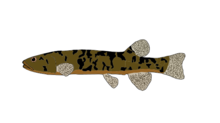The Pedder galaxias (Galaxias pedderensis) is an Australian freshwater fish. It is considered to be extinct in the wild since 2005 by the EPBC Act, and was originally found only in Lake Pedder in Tasmania.
| Pedder galaxias | |
|---|---|

| |
| Scientific classification | |
| Domain: | Eukaryota |
| Kingdom: | Animalia |
| Phylum: | Chordata |
| Class: | Actinopterygii |
| Order: | Galaxiiformes |
| Family: | Galaxiidae |
| Genus: | Galaxias |
| Species: | G. pedderensis
|
| Binomial name | |
| Galaxias pedderensis Frankenberg, 1968
| |
Range edit
Originally recorded only in Lake Pedder and inflowing streams, after the construction of the Huon–Serpentine dam in 1972 (the "new" Lake Pedder), its range expanded initially into Lake Gordon and Wedge River. However, by 1980 it had become very rare and no new specimens have been captured in the wild since 1996. Introduced trout are implicated as a major factor in the decline of this species. The species survives in two translocated populations outside its original range, one at Lake Oberon in the Western Arthurs mountain range and one at a modified water supply dam near Strathgordon.[2]
Description edit
A small greenish-brown fish, off-white to silvery belly, a profuse irregular and highly variable pattern of alternating off-white and brownish contrasting bands extending into the base of the fins and breaking up into fine spots on the lower part of the sides. Length to 160 mm.
Habitat edit
Before the construction of the new lake, this species preferred Lake Pedder itself which was quite shallow surrounded by white sandy beaches and small rooted aquatic vegetation as well as in swamps and low velocity waters with abundant instream organic debris and overhanging terrestrial vegetation.[3]
Diet consists of small invertebrates, particularly arthropods and aquatic insect larvae, crustaceans and terrestrial insects especially beetles, flies, cicadas etc.[3]
Conservation status edit
Reproduction edit
Females are larger than males. Male genital papilla narrow, whereas female are broad and rounded, most noticeable during breeding season. 150 to 1,200 eggs averaging 1.9 mm to 2.3 mm in diameter when water hardened. Spawning reported to occur in spring (October) at water temperatures of 6.7 to 7.5 °C.
See also edit
References edit
- ^ a b Freeman, R. (2019). "Galaxias pedderensis". IUCN Red List of Threatened Species. 2019: e.T8808A129041339. doi:10.2305/IUCN.UK.2019-3.RLTS.T8808A129041339.en. Retrieved 19 November 2021.
- ^ a b c "Australian Department of the Environment and Heritage (2006). "Galaxias pedderensis" in Species Profile and Threats Database, Department of the Environment and Heritage, Canberra". Deh.gov.au. 13 March 2012. Retrieved 6 July 2012.
- ^ a b Gomon, Martin F.; Bray, Dianne J. "Pedder Galaxias, Galaxias pedderensis Frankenberg 1968 More Info". Fishes of Australia. OzFishNet & Museums Victoria. Retrieved 3 October 2020.

